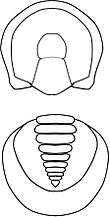Jinghediscus
Jinghediscus is an extinct genus from a well-known class of fossil marine arthropods, the trilobites. It lived during the lower Middle Cambrian, with remains found in China (Xinjiang) and Australia (Queensland).
| Jinghediscus | |
|---|---|
 | |
| Jinghediscus nummularius | |
| Scientific classification | |
| Kingdom: | |
| Phylum: | |
| Class: | |
| Order: | |
| Family: | |
| Genus: | Jinghediscus Xiang & Zhang, 1985 |
| species | |
| |
Description
Like all Agnostida, Jinghediscus is diminutive and the headshield (or cephalon) and tailshield (or pygidium) are of approximately the same size (or isopygous) and outline. Like all Weymouthiidae, Jinghediscus lacks eyes and rupture lines (or sutures). The cephalon is semi-elliptical. The central raised area of the cephalon (or glabella) has one furrow and the posterior part is inflated. The glabella does not nearly reach the broad border furrow. The occipital ring (or L0) is ill-defined, and it does not carry a spine. The anterior border of the cephalon is long, only gently convex, and becoming less deep further from the axis. The border furrow runs all along the margin. The pygidium has the same outline as the cephalon, with a strongly conical axis of ten rings. The areas left and right of the axis (or pleural areas) are smooth. The pygidial border furrow cannot be distinguished, the border is concave close to the pleural areas and very wide, comparable to the pleural areas.[1]
References
- Whittington, H. B. (1997). Volume 1 – Trilobita – Introduction, Order Agnostida, Order Redlichiida. Treatise on Invertebrate Paleontology. Part O, Revised. pp. 393–394.